The real secret to a blissfully comfortable bed does not start with the duvet or pillows. It begins much deeper, with the foundational layers that support you all night long. Before you even think about sheets, focusing on the right mattress and a quality topper can completely transform your sleep experience. It is all about creating a base that is built for true rest and restoration.
Building Your Bed's Comfort Foundation
Think of a truly comfortable bed as an investment in your wellbeing. The mattress, protector, and topper are your essential building blocks for achieving that perfect night’s sleep. Getting this foundation right is the first, most crucial step in turning your bed from just a piece of furniture into a personal sanctuary.
And it seems many of us are realising just how important this is. Here in the UK, we're spending more than ever on quality bedding. The bed linen market alone is valued at an impressive USD 1,820.45 million, which speaks volumes about our desire for comfortable, stylish bedrooms.
Choosing the Right Mattress
Let's be clear, your mattress is the single most important part of this equation. The right one supports your body correctly, eases pressure points, and is the difference between waking up refreshed or feeling like you have gone ten rounds. You will generally come across three main types: memory foam, pocket sprung, and hybrids, and each offers a very different sleep experience.
- Memory foam is fantastic because it contours to your body, essentially hugging you. This makes it a popular choice for many side sleepers who need that extra cushioning for their hips and shoulders.
- Pocket sprung mattresses offer that more traditional, responsive feel. They have great airflow, which is a real bonus if you tend to sleep hot.
- Hybrids aim to deliver the best of both worlds by combining the sturdy support of springs with the plush comfort of a foam layer on top.
This chart gives a great visual breakdown of how people rate the comfort of different mattress types.
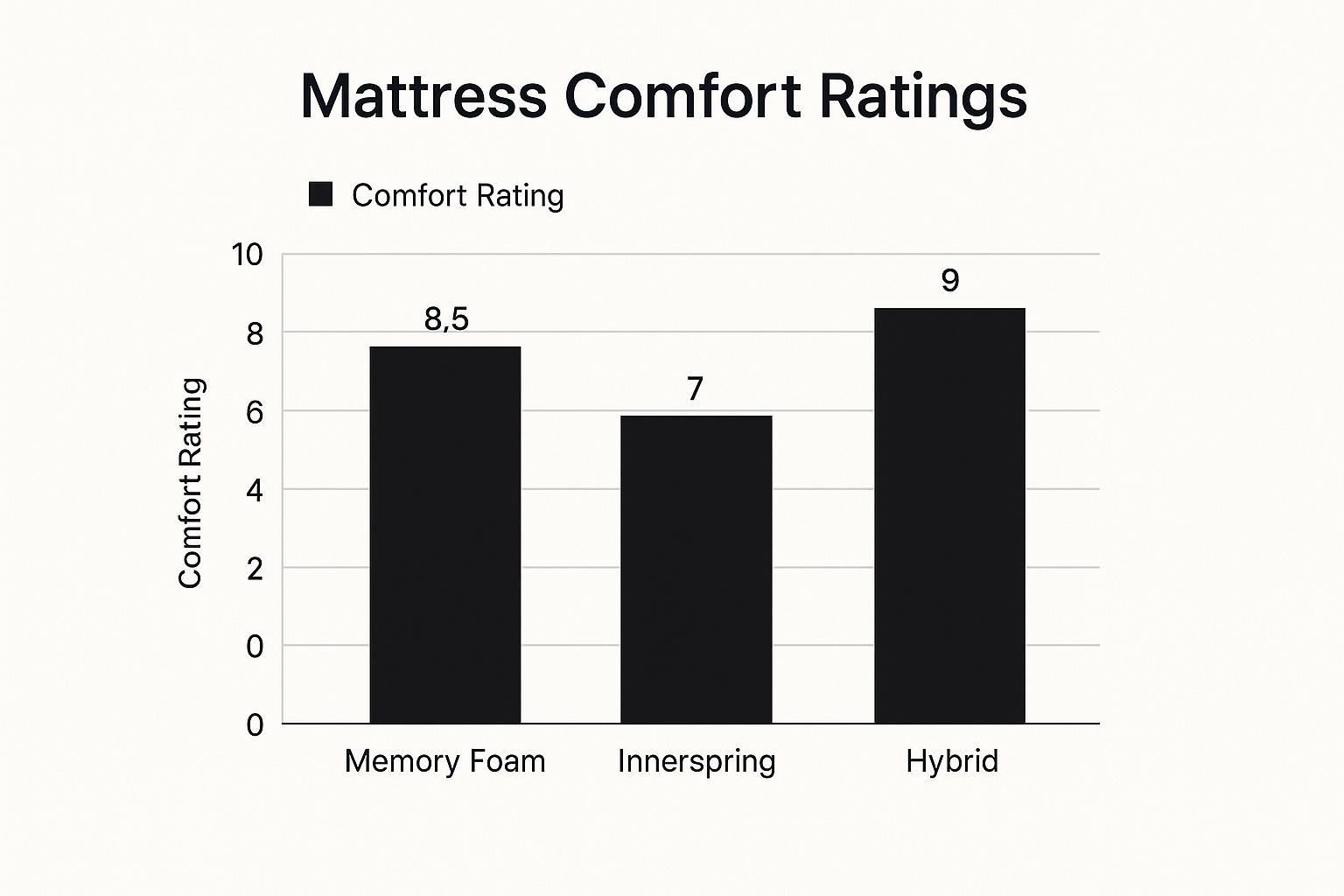
As you can see, hybrids often come out on top, hitting that sweet spot between supportive and plush.
The Game Changing Mattress Topper
What if a new mattress is not on the cards right now? This is where a mattress topper becomes your best friend. It is a brilliant and affordable way to instantly upgrade your bed.
A good topper can soften up a mattress that feels a bit too firm, add a supportive layer to one that is feeling a little tired, or just introduce a fresh, cloud like feel. They also do double duty by protecting your mattress from general wear and tear, extending its life.
Here is a quick comparison to help you find the perfect fit for your bed.
Choosing Your Comfort Foundation
| Topper Material | Best For | Feel |
|---|---|---|
| Memory Foam | Contouring comfort and pressure relief | Cradling, slow sinking |
| Microfibre | A plush, "down like" feel without the price | Soft, airy, and light |
| Wool | Natural temperature regulation and softness | Cosy, breathable, and supportive |
Ultimately, a topper is a simple addition that can make a massive difference to your overall comfort.
Just a practical tip, whenever you add new layers like a topper, it is a good idea to double check your measurements for sheets. You might need a deeper fitted sheet to accommodate the extra height. You can find more details on getting your king size bedsheet size in cm just right.
Choosing the Right Bedding Materials
The fabrics touching your skin play a massive part in how well you sleep. Choosing the right material is about so much more than just the colour or pattern; it is about crafting a sensory experience that helps you unwind and drift off, turning your bed into that hotel quality escape you deserve.
It really starts with understanding what feels best for you. While many of us have been taught to chase a high thread count, that is only part of the story. A higher number can mean a softer sheet, but the type of fibre and the weave are arguably more important for creating that truly luxurious feel.
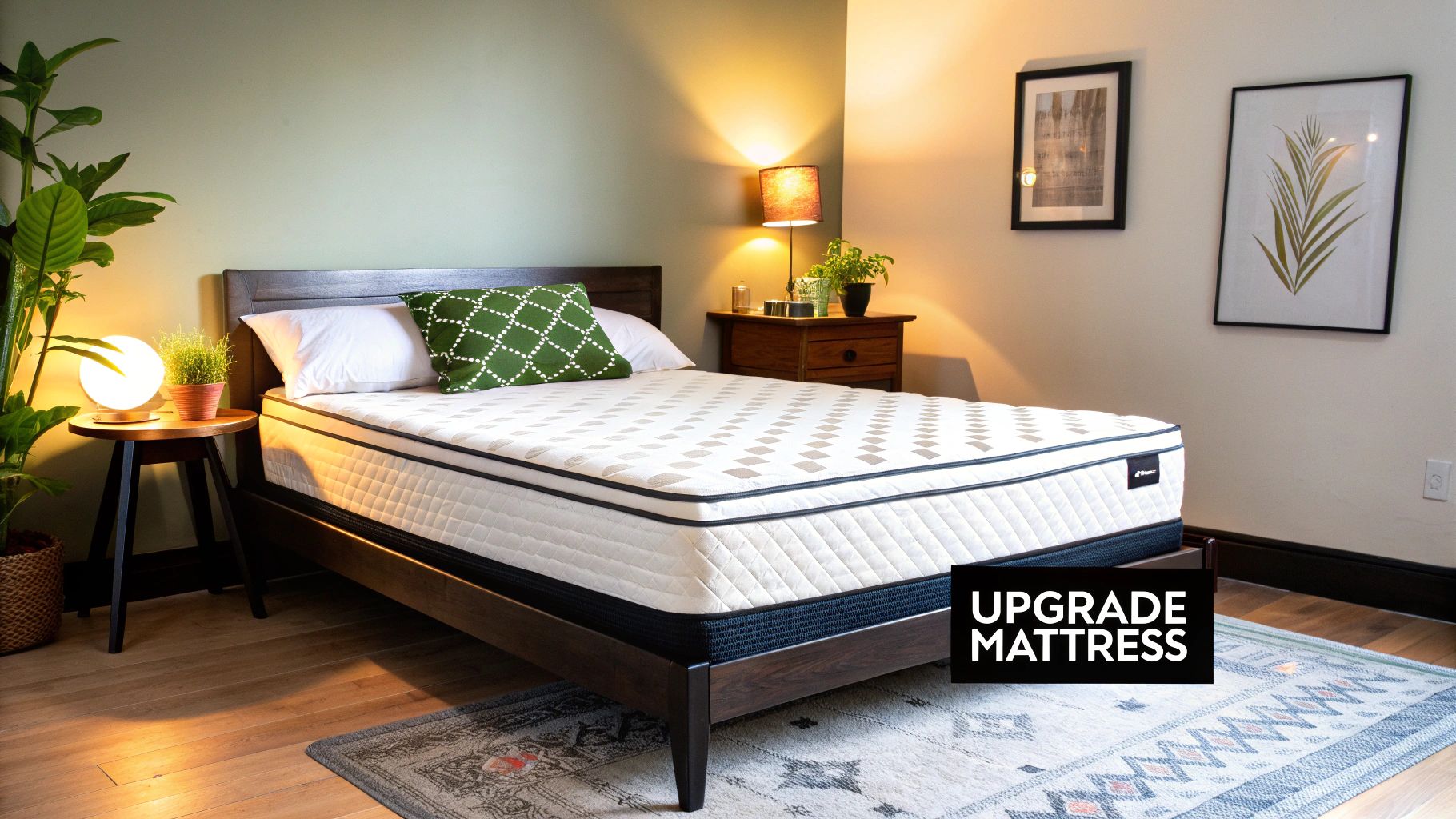
Find Your Perfect Fabric Feel
Every material offers a completely different feel, so it is worth thinking about what you value most. Are you someone who loves a crisp, cool touch, or do you prefer something silky and smooth?
- Cotton Percale: If that crisp, cool feeling of freshly laundered hotel sheets is what you are after, percale is your perfect match. It is incredibly lightweight and breathable, making it ideal for warmer months or for anyone who tends to sleep hot.
- Cotton Sateen: For a touch of opulence, sateen offers a silky smooth finish and a subtle sheen. It drapes beautifully and feels incredibly soft against the skin. It is also a little heavier than percale, which is lovely for cooler nights.
- Linen: Effortlessly breathable and with a relaxed, lived in look, linen is a fantastic choice for year round comfort. It is a natural temperature regulator, keeping you cool in summer and cosy in winter, and has that wonderful quality of getting softer with every single wash.
Of course, the sheets are just the beginning. The choice of duvet and its cover is just as vital for overall comfort. If you want to get this part just right, you can explore our guide on what are duvets and their covers to help complete your perfect bedding setup.
Choosing the right material is a personal journey. What one person finds blissful, another might find too warm or too crisp. The key is to match the fabric's properties to your own sleep preferences.
These days, creating a comfortable bed also means making conscious choices. A growing number of us are seeking out bedding made from sustainable sources like organic cotton. In fact, recent surveys show that over 40% of UK shoppers are now willing to pay more for bedding that is both comfortable and kinder to the environment. It is clear that preferences are shifting towards quality and sustainability.
The Art of Layering for Year Round Comfort
A truly comfortable bed is one that adapts to you, no matter the season. The secret lies in mastering the art of layering, which lets you create an inviting sleep space that feels just right on a cool summer evening or a frosty winter morning. It is about building a bed that is as practical as it is beautiful.
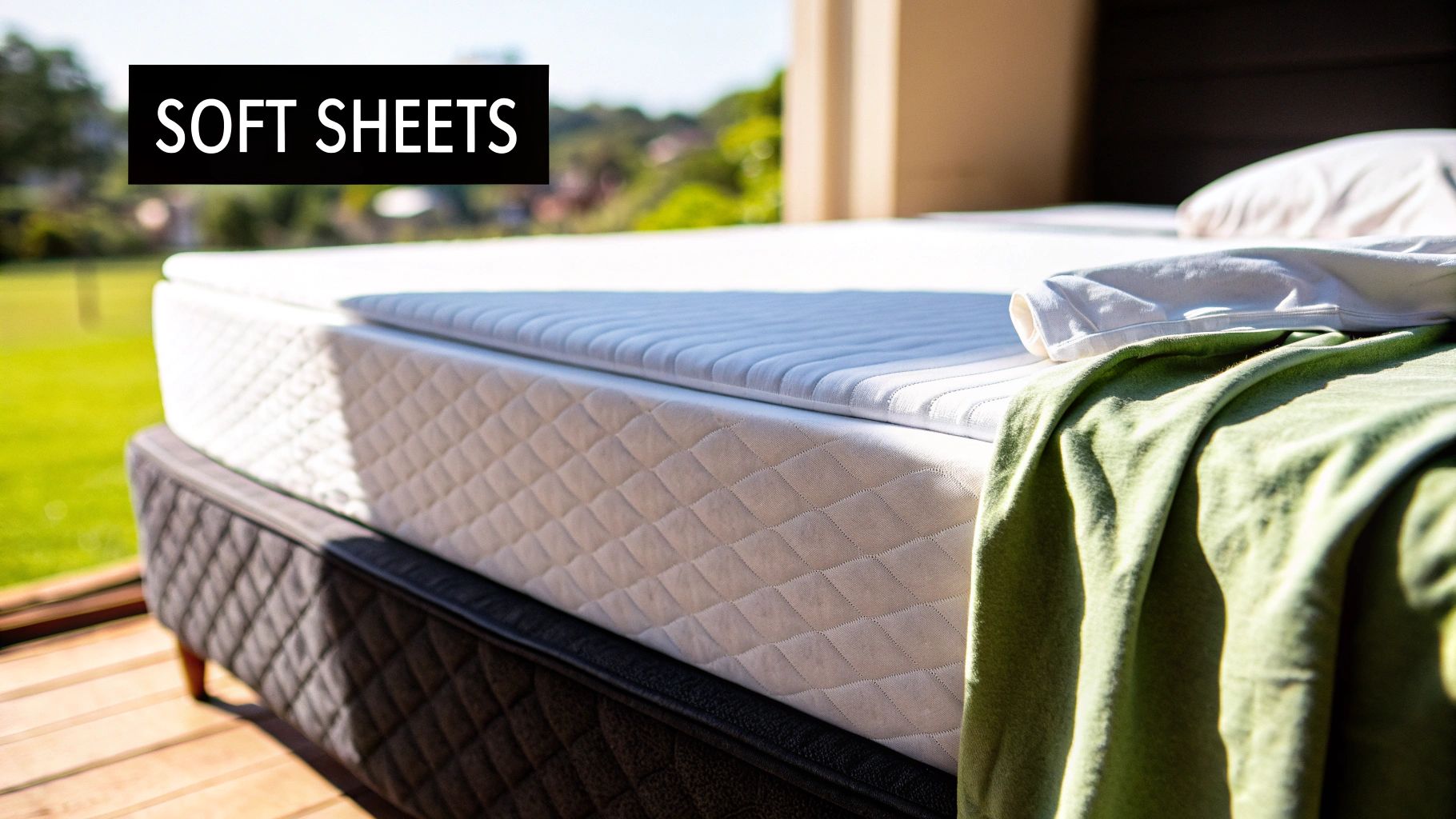
This approach goes far beyond a simple sheet and duvet. Instead, I want you to think of your bed in terms of different textures and weights that you can easily add or remove. A lightweight quilt, a cosy blanket, and your main duvet can all work in harmony, giving you complete control over your comfort.
Not only does this method improve temperature regulation, but it also adds wonderful visual depth and a stylish, lived in feel to your bedroom.
Building Your Year Round Bed
To create a bed that works for you every single night, you just need a few key pieces that can be combined in different ways.
- Your Main Duvet: For the classic UK climate, the tog rating is everything. A 10.5 tog duvet is what I generally recommend as the ideal year round choice, offering plenty of warmth for most of the year without feeling stifling.
- A Lightweight Quilt: This is your summer hero, perfect for nights when a full duvet is just too much. Come winter, it becomes an excellent extra layer over your main duvet.
- A Textured Throw: Think of a chunky knit or a soft fleece blanket. This is your final touch, adding both style and an extra bit of cosiness on those particularly cold nights.
The real beauty of layering is its flexibility. You can easily peel back a layer if you get too warm or snuggle under an extra blanket when it is chilly, all without having to get out of bed.
For instance, in the middle of summer, you might find a top sheet and a lightweight quilt are all you need. As autumn rolls in, you can bring back your 10.5 tog duvet. Then, when winter truly sets in, draping that plush throw over the top gives you that final, comforting weight. It is a simple system that guarantees you will always know how to make your bed more comfortable, whatever the weather is doing outside.
Finding the Perfect Pillows and Cushions
Pillows are so much more than just decorative fluff; they are absolutely fundamental to your comfort and alignment every single night. If you are serious about making your bed more comfortable, getting the pillow setup right is a must. It is what ensures your head and neck get the support they need to fully relax.
The truth is, the "perfect" pillow is a deeply personal choice that depends almost entirely on how you sleep.
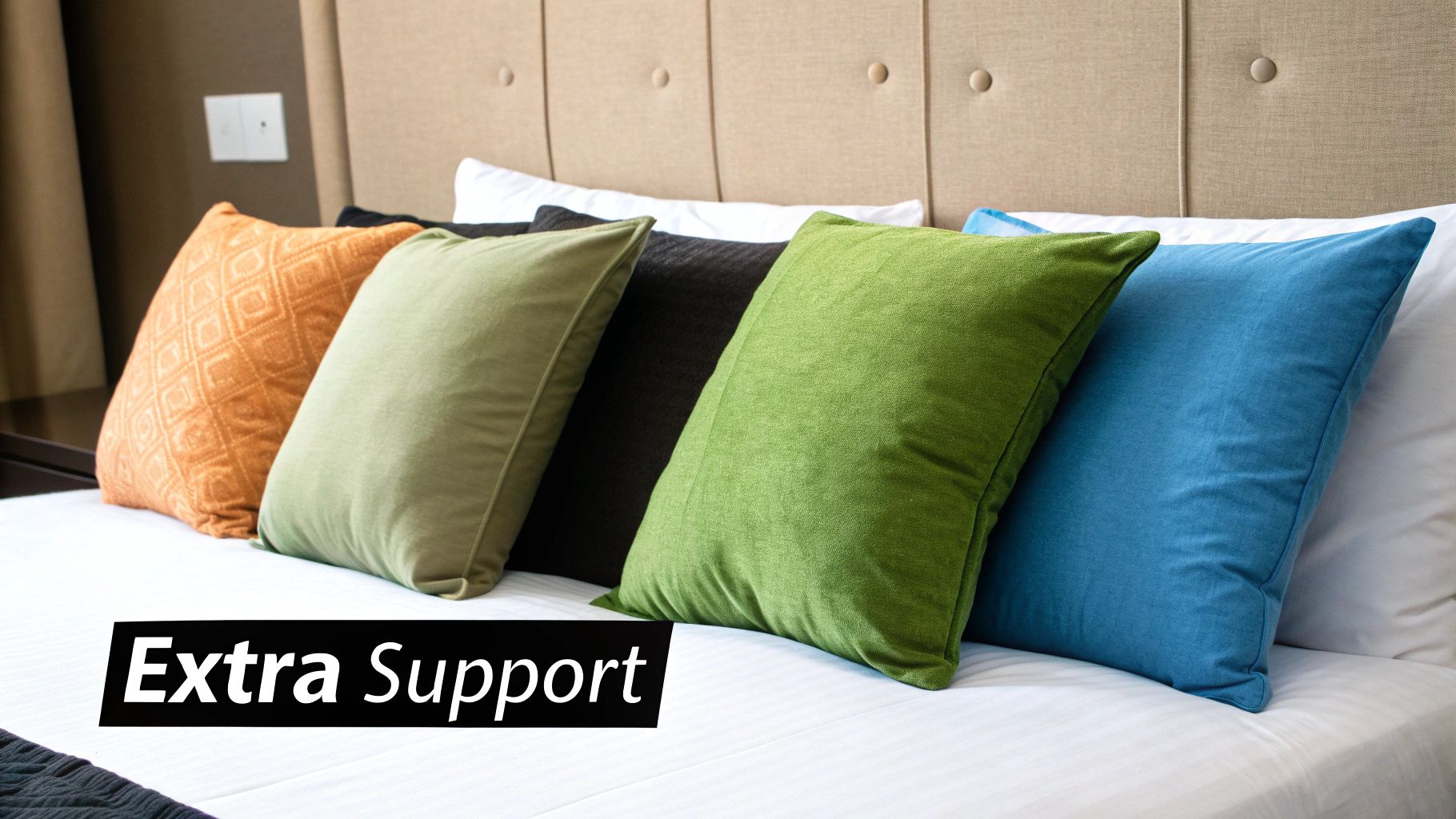
Think about it, your sleeping position dictates the exact kind of support you need. A pillow that is too high or too low can easily lead to neck strain and morning stiffness. Matching your pillow to your sleep style is the single best way to wake up feeling refreshed and ache free.
Match Your Pillow to Your Sleep Style
Choosing the right pillow starts with being honest about how you spend most of the night. Are you typically on your back, side, or front?
- Side Sleepers: You need a firmer, higher pillow. The goal is to perfectly fill the space between your ear and your shoulder, which keeps your spine beautifully straight.
- Back Sleepers: A medium loft pillow is generally your best bet. It provides just enough support to cradle your head without pushing it too far forward and straining your neck.
- Stomach Sleepers: This is where less is more. A very thin, soft pillow, or sometimes no pillow at all, is often the most comfortable option. It prevents your neck from arching backwards into an unnatural position.
Beyond the height, the filling completely changes the feel. Memory foam offers that firm, contouring support that moulds to your unique shape, while down or microfibre provides a soft, cloud like feel that is wonderfully plush and often hypoallergenic.
The right pillow should feel like it was made just for you. It supports the natural curve of your neck, allowing your muscles to completely relax while you sleep.
Choosing the right pillow can feel a bit overwhelming, so here is a quick guide to help you find your perfect match.
Pillow Finder for Your Sleep Style
| Sleeping Position | Recommended Pillow Type | Key Benefit |
|---|---|---|
| Side | A firm, high loft pillow (e.g., memory foam) | Maintains spinal alignment |
| Back | A medium loft, supportive pillow | Cradles the head without straining the neck |
| Stomach | A soft, thin pillow (e.g., microfibre) or none | Prevents unnatural neck arching |
This table should point you in the right direction, helping you select a pillow that works with your body, not against it.
Finally, let us not forget the finishing touches. A couple of stylish cushions do more than just complete the look of your bed, they also offer brilliant back support when you are sitting up to read or relax. Think of them as the final, functional layer in your comfort puzzle.
Maintaining That Fresh and Cosy Feeling
Once you have created the perfect sleep sanctuary, the real secret to lasting comfort is keeping it fresh and inviting. It is the small, consistent habits that make all the difference, turning that incredible feeling of slipping into a clean, cosy bed from a rare treat into an everyday luxury.
Regularly washing your bedding is essential. For the best hygiene and softness, I always recommend washing your sheets and pillowcases once a week. Your duvet cover can usually stretch a bit longer, maybe every two weeks, unless it is the height of summer.
Simple Care for Lasting Softness
How you look after your bedding has a direct impact on its lifespan and how it feels against your skin. Always opt for a gentle detergent and avoid washing at high temperatures; this simple step protects the delicate fibres, keeping them soft and preventing them from wearing out too soon.
Another little trick I swear by is pulling the duvet back for about 30 minutes each morning. This allows any moisture from the night to evaporate, which goes a long way in keeping your bed feeling fresh.
A well cared for bed does not just feel more comfortable; it actively contributes to a healthier sleep environment by keeping dust mites and allergens in check.
For speciality items like comforters, following the right care instructions is key. You can find all the details you need in our Snuggle comforter care guide to ensure yours stays cloud like for years. It is these small routines that truly teach you how to make your bed more comfortable, day in and day out.
Answering Your Top Questions About Bed Comfort
We often hear the same questions about getting a bed just right. It seems many of us are wrestling with the same small but frustrating issues. Let's tackle some of the most common queries and get you past those final hurdles to a truly comfortable night's sleep.
My Mattress Feels Too Firm, What Can I Do?
This is a classic problem, especially when a mattress is brand new. Before you even consider the hassle of a return, the simplest and most effective fix is a good mattress topper. A plush microfibre or memory foam topper can work wonders, adding an immediate layer of softness that makes a firm surface feel much more welcoming.
It is also worth remembering that most new mattresses need a little time to settle in. There is often a break in period of up to 60 days as the materials soften and adapt. A little patience can go a long way.
How Should I Choose Bedding for Sensitive Skin?
If you have sensitive skin, your focus should be on soft, breathable fabrics. Natural fibres are always the best choice.
- 100% Cotton: Specifically, look for long staple varieties like Egyptian or Pima cotton. Their longer fibres create a smoother, more durable weave that is less likely to irritate.
- Linen: A brilliant choice. It is naturally hypoallergenic and has the unique quality of getting softer with every wash, making it incredibly gentle on the skin over time.
- Bamboo: This material has a silky, cool to the touch feel and is fantastic at wicking away moisture, which helps keep your skin dry and comfortable all night.
Whatever you choose, check for an OEKO-TEX certification. This label guarantees the fabric is free from harmful chemicals, giving you peace of mind that nothing will aggravate your skin.
A common pitfall is not the fabric, but the detergent. Always use a gentle, non biological washing liquid and skip the fabric softener. Fabric softeners can leave a chemical residue on the fibres that is a frequent cause of skin irritation.
Is It Really a Good Idea to Buy Bedding Online?
Without a doubt. Shopping for bedding online has completely opened up a new world of choice and convenience. The UK's online bedding market is projected to generate over US$310.98 million in revenue this year alone, which just shows how many people have embraced it.
Buying online means you can effortlessly compare materials, sift through real customer reviews, and find a far greater range of styles and niche brands than you would ever see in a physical shop. You can read up on these market trends and UK shopping habits for more fascinating insights.
Ready to build your perfect sleep sanctuary? The Morgan and Reid collection features everything from our signature Snuggle Comforters to luxurious sheets and pillows, all designed for dreamers and comfort seekers alike. Explore our collection today and start layering the bed you have always wanted.


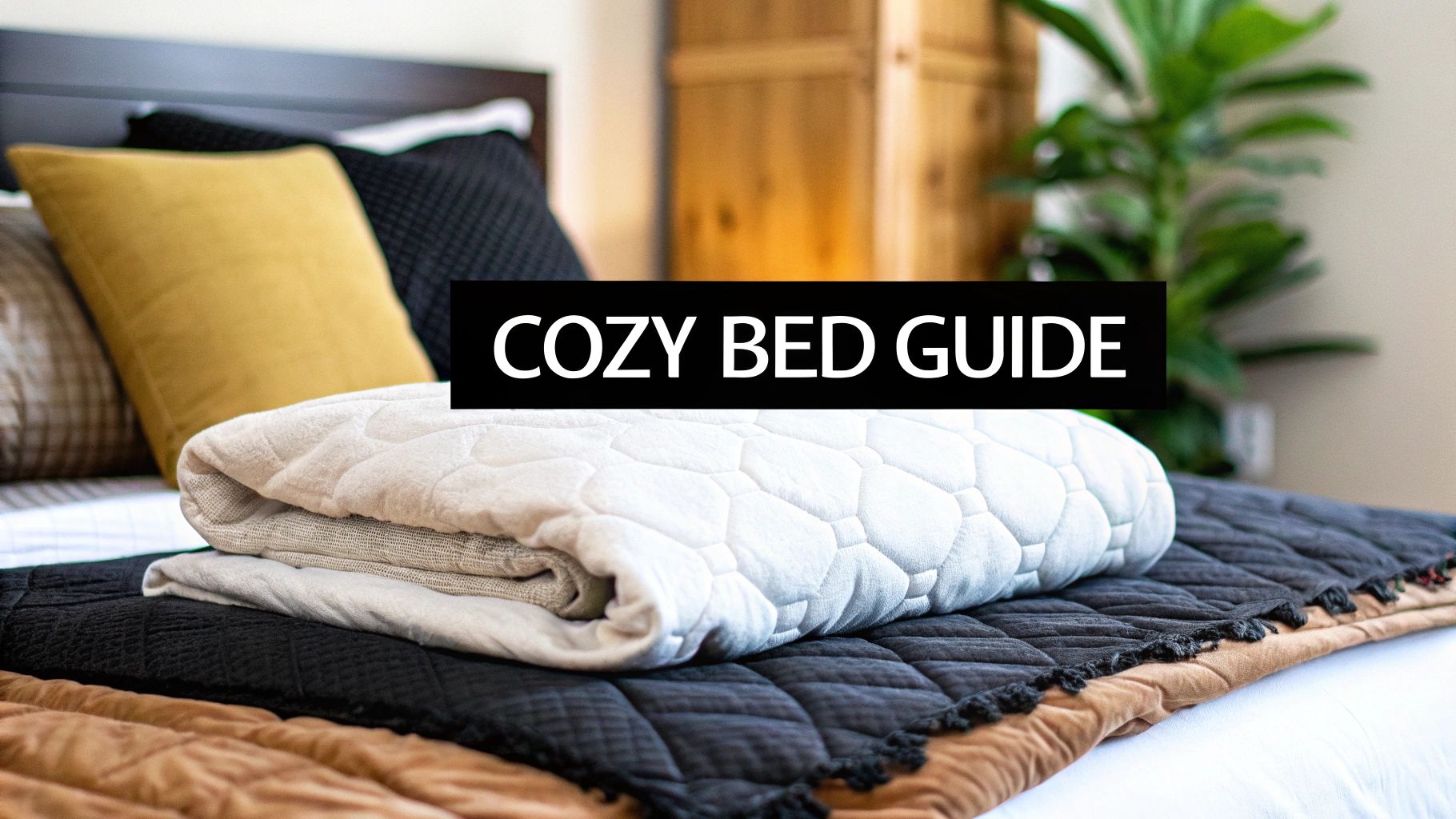
Share:
10 Modern Bedroom Colour Schemes for a Stylish Sanctuary
How to Make Your Bed Feel Like a Five-Star Hotel